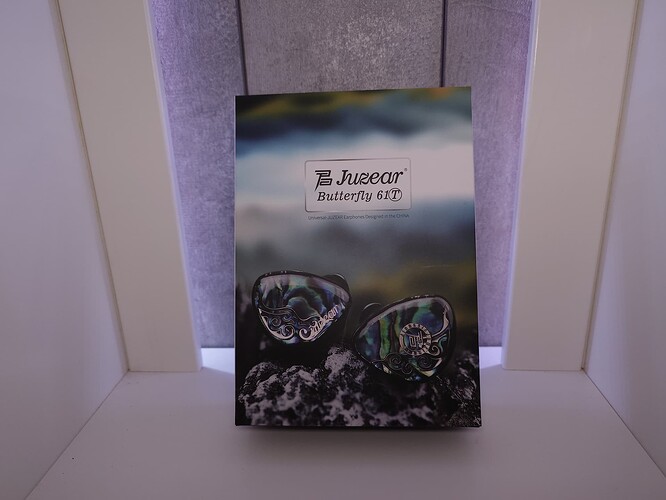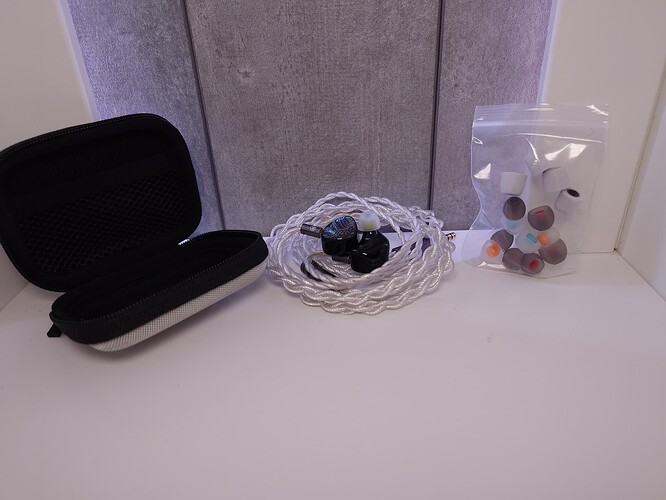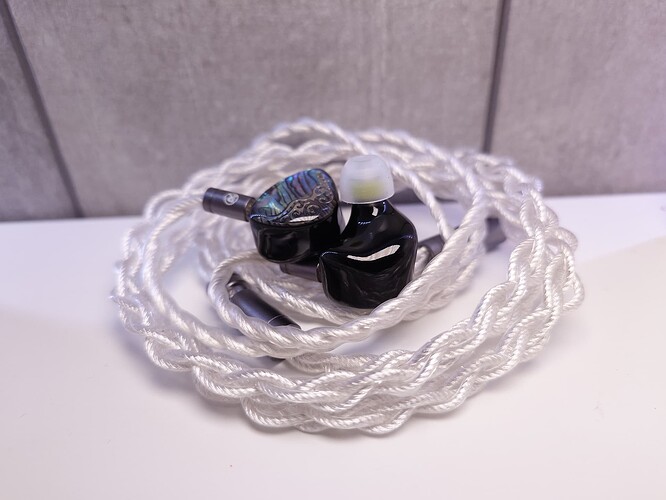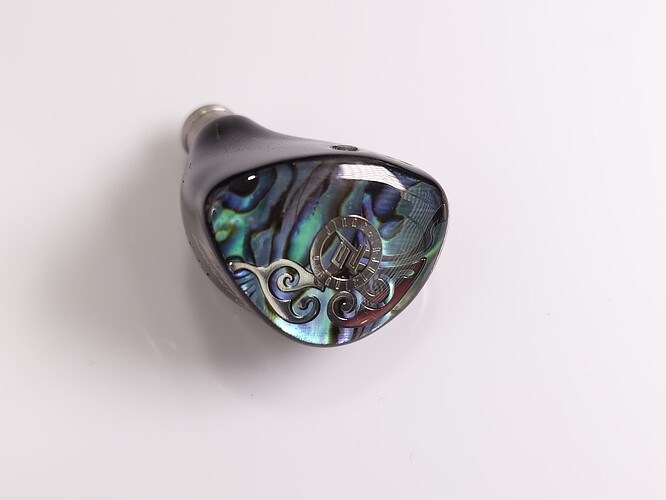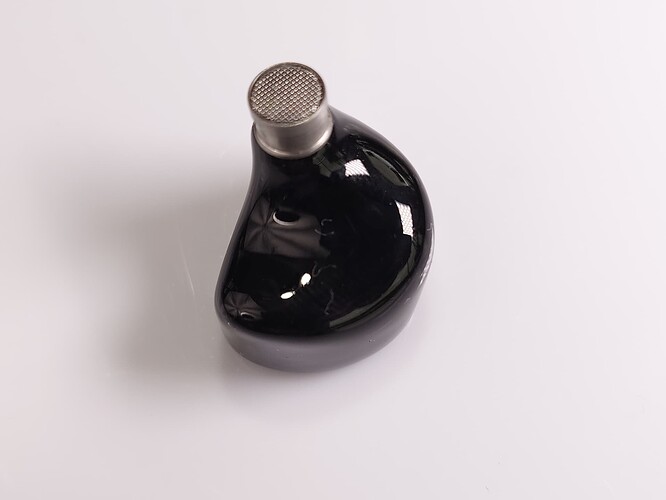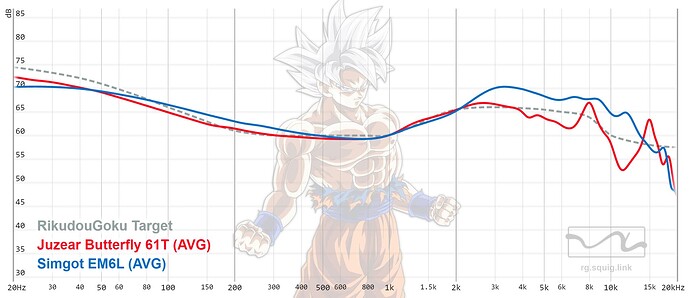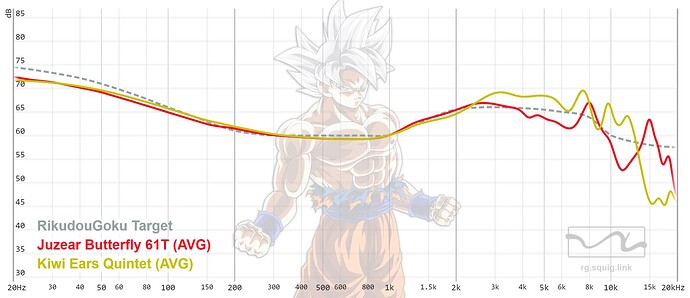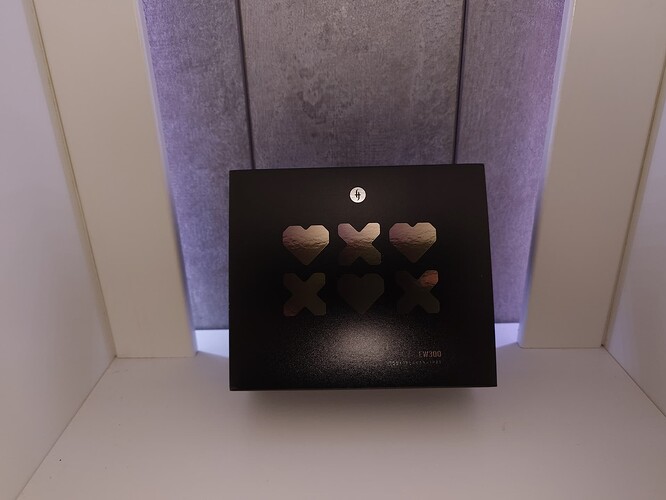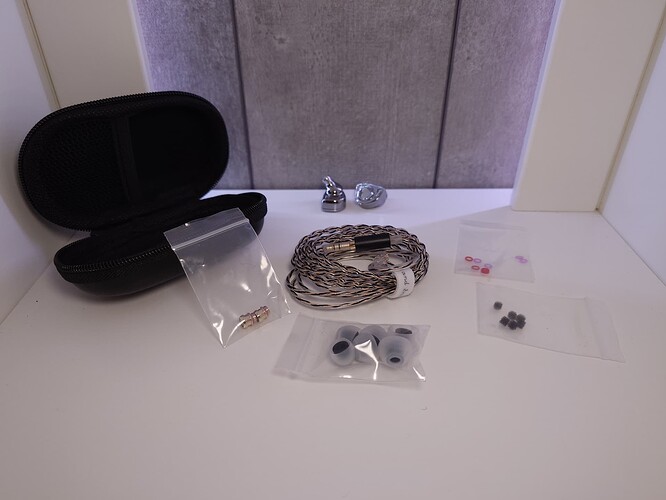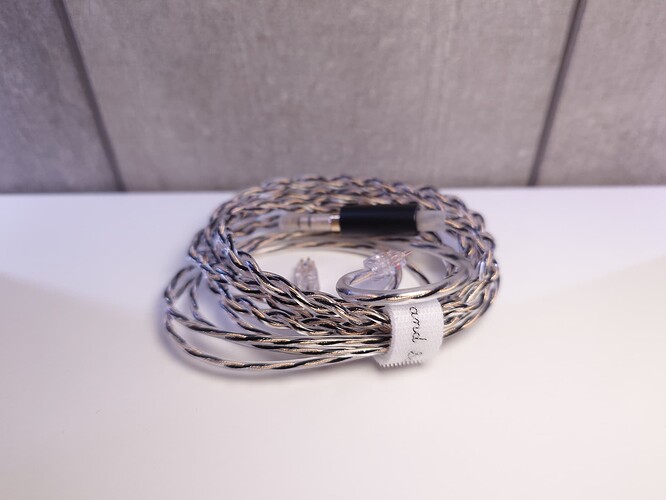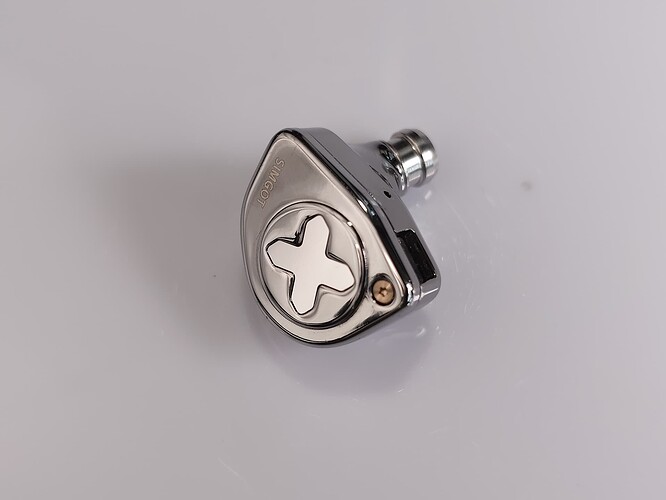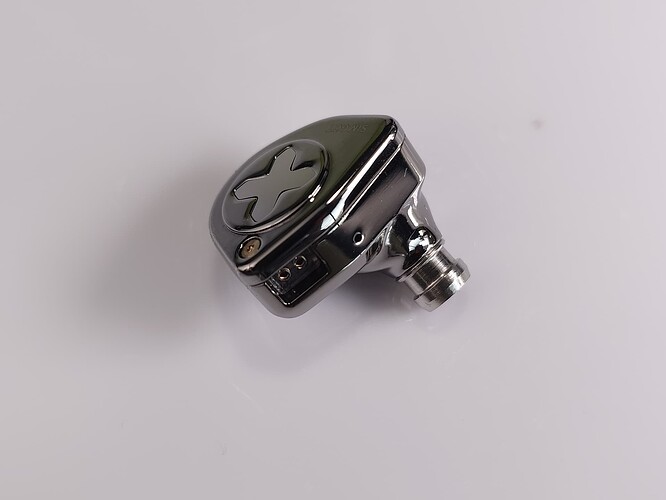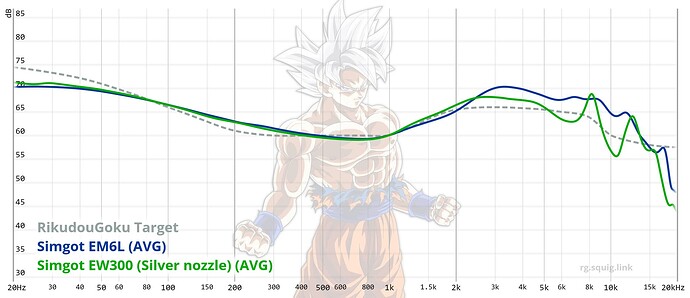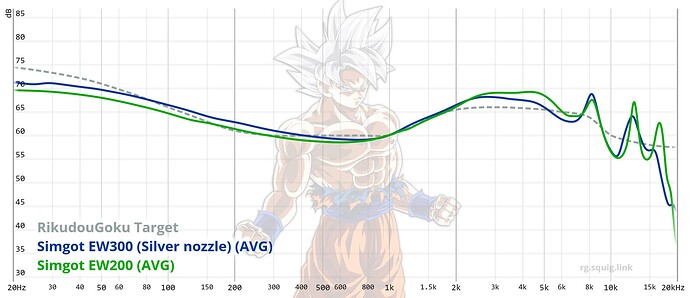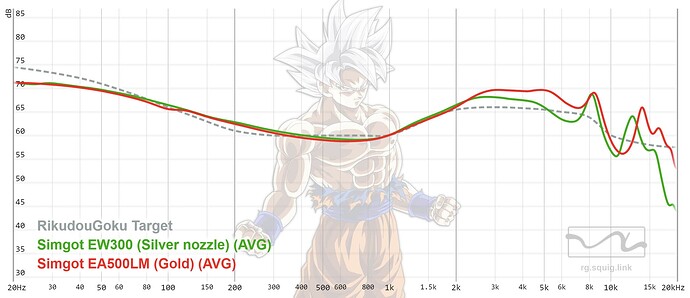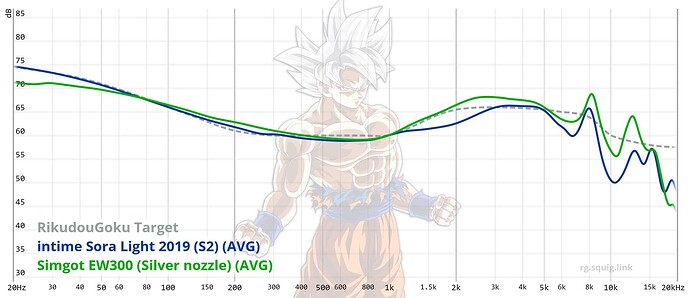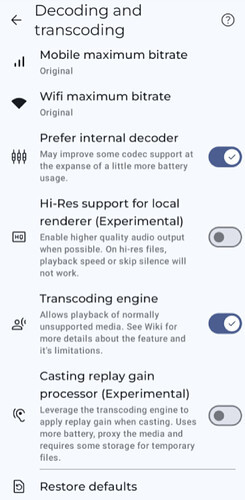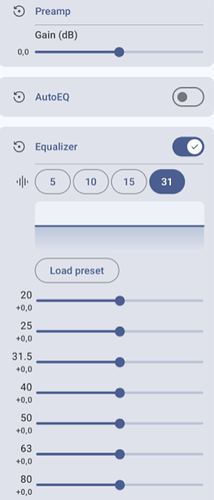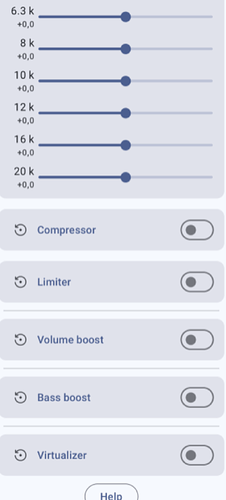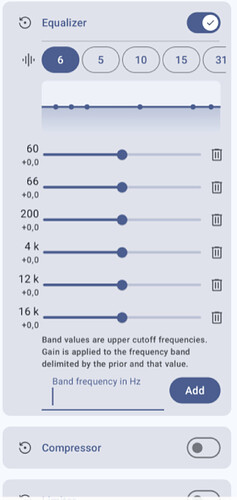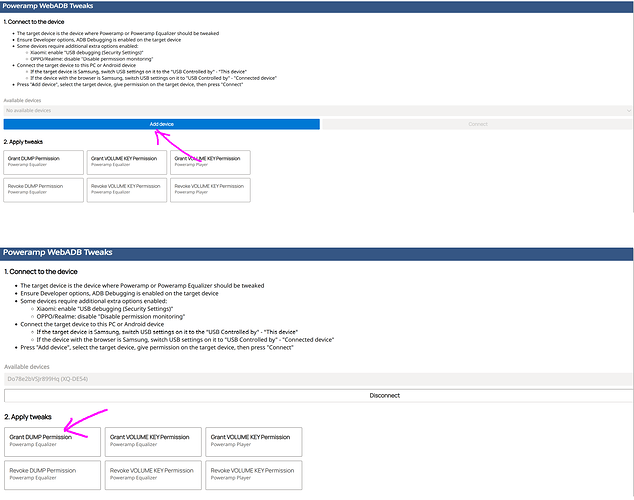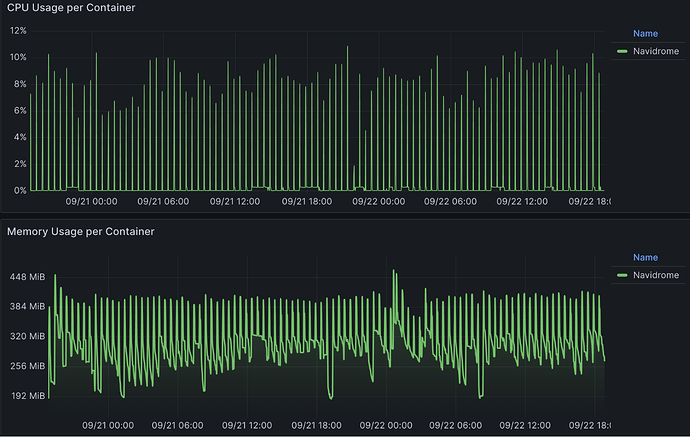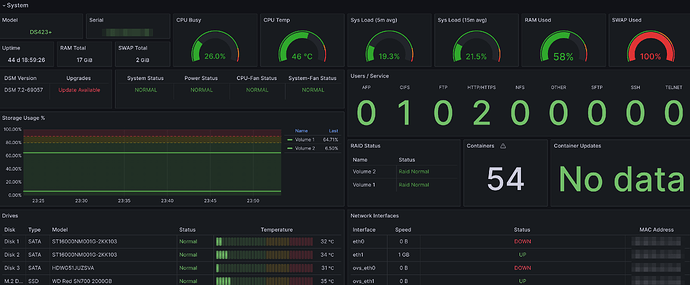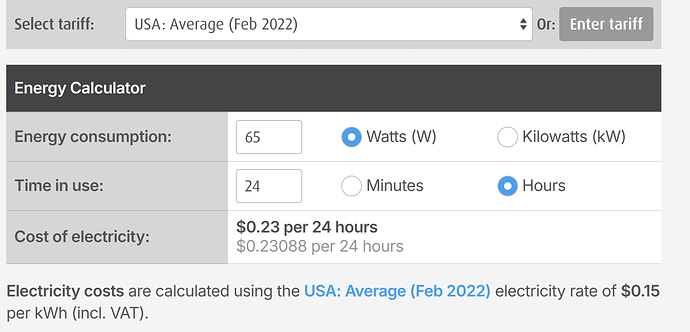Sounds right up my alley, thanks for the tip!
These arrived today and are exactly as described sonically. Fit and comfort were good for me since I like softer tips, but they’re probably not ever going to be used regularly or ever by me. It wasn’t unpleasant or noticeably wrong, but I can’t ever see my self reaching for a set of tips like this given my preferences.
2024-08-17: Juzear 61T
Non-sound: Shell is on the larger side and only has a small vent near the connector so there is noticeable pressure build up and is not comfortable (also has a very small wing that I dislike). The nozzle is on the larger side as well at 6.5mm on the lip and 6.1mm below it. Cable is a pretty thick 4-core cable with a working chin-slider and metal connectors/divider.
| Juzear 61T | Simgot EM6L | |
|---|---|---|
| Sub-bass | + | - |
| Mid-bass | + | - |
| Lower-mids | = | = |
| Upper-mids | - | + |
| Treble | - | + |
| Upper-treble | - | + |
| Soundstage | = | = |
| Imaging | - | + |
| Separation | - | + |
| Macro-detail | - | + |
| Micro-detail | - | + |
| Timbre | - | + |
Sub-bass quantity is higher on the 61T and rumbles a bit more but similar extension, speed and tightness. Mid-bass quantity is a bit higher and more textured on the 61T with similar speed but tighter on the EM6L. Male vocals have a more natural tonality due to the warmth and thicker note-weight along with a bit more quantity however the timbre is quite bad in comparison so it ends up less natural. Female vocals are a bit brighter and smoother on the EM6L but a bit less forward than the 61T but much more natural timbre. Treble is a lot airier and more clarity on the EM6L but is actually smoother despite it having more quantity. Stage is slightly deeper on the 61T but a bit wider on the EM6L. Detail, imaging and separation are better on the EM6L. Timbre on the other hand is frankly horrible on the 61T compared to the EM6L which might as well be a single DD in comparison to the mess of a timbre that the 61T is….
Overall, there is only 1 reason why I would recommend the 61T over the EM6L and that is if you want something warmer, and even then, there are plenty of other better options that are cheaper than the 61T anyway….
| Juzear 61T | Kiwi Ears Quintet | |
|---|---|---|
| Sub-bass | - | + |
| Mid-bass | - | + |
| Lower-mids | = | = |
| Upper-mids | - | + |
| Treble | - | + |
| Upper-treble | - | + |
| Soundstage | + | - |
| Imaging | = | = |
| Separation | = | = |
| Macro-detail | = | = |
| Micro-detail | = | = |
| Timbre | - | + |
Mid-bass quantity is lower on the Quintet but has more texture and is both a bit faster and tighter. Sub-bass extends a bit lower and a bit tighter and faster on the Quintet while it rumbles a bit more on the 61T. Male vocals are near identical but more natural due to the better timbre on the Quintet. Female vocals are slightly more forward, brighter and more clarity on the Quintet and more natural overall. Treble is airier and cleaner on the Quintet although not as smooth as the 61T, timbre is better on the Quintet and is more natural overall. Stage is a bit wider and deeper on the 61T. Detail, imaging and separation are similar. Timbre and coherency are better on the Quintet.
Overall, the Quintet is quite similar but is doing a better job than the 61T and is at the same price and also a quadbrid than just a hybrid. Just get the Quintet over the 61T if u want something like this.
Conclusion: I cannot recommend the Juzear 61T as I frankly don’t see the point of it, it is tuned to be a jack of all trades, master of none set but the timbre is noticeably unnatural so it is neither a fun nor accurate set.
Rank: B-
So here’s a newbie question–how do you configure these things? i.e., how do you know that they are receiving a DSD signal or Hi-Res PCM if Android natively wants to feed them 16/48?
there are apps that bypass android audio and just play the file at its sample rate
Uapp and poweramp are a couple I can think of
the hiby app (free!) can do this too.
As the 2 above says, there are apps that bypasses the Android software restrictions. UAPP, Poweramp, Neutron and Hiby are the well known ones to do it. Poweramp is the one I would recommend out of the 3 paid ones.
@Rikudou_Goku Do you have any thoughts on the Penon Conductor? ![]()
A BC driver on a earbud.
He said it was a useless idea I think but I’m sure he can elaborate as to why.
It’s also $150 AFTER a $50 loyalty discount. I just don’t see it being worth that and in my eyes it just looks so awful.
As @rattlingblanketwoman mentioned, useless idea. One that I also tried in the past and CVJ/TRN has as well.
-
BC requires a GOOD fit and one that is stable and in as much contact to your ears as possible to effectively transfer the vibrations. Buds do not seal in your ears and this particular shell doesnt look like it is in contact with your ears much at all.
-
BC drivers the size of iem/buds are only gonna operate at the lower mids/mid-bass at the lowest due to how small they are.
-
Putting another driver into the shell of a bud is likely gonna bottleneck the DD (due to wasted space).
2024-09-05: Simgot EW300
Non-Sound: Identical shell to the EW200, (rest is copy pasted from EW200 review) “Comfortable shell due to the slightly smaller than average size and a good shape for my ears, has a good venting implementation with the inner vent and one near the 2pin connector which leads to no pressure issues. Cable is identical to the one in the EA500 except a different wire color, working chin-slider with plastic connectors/divider.”
Nozzles: The stock silver nozzle is the brighter one overall while the gold nozzle is warmer due to the slightly higher bass shelf. The treble is more noticeable (and also the piezo) with the gold nozzle due to both the higher bass shelf as well as the slightly reduced upper-mids/lower-treble although vocals are pretty similar. Overall while I do personally prefer the warmth from the gold nozzle, the silver nozzle is the better one overall and it is what I will be using from now on.
| Model | Simgot EW300 (Silver Nozzle) | Simgot EM6L |
|---|---|---|
| Sub-bass | + | - |
| Mid-bass | + | - |
| Lower-mids | + | - |
| Upper-mids | - | + |
| Treble | = | = |
| Upper-treble | = | = |
| Soundstage | = | = |
| Imaging | - | + |
| Separation | - | + |
| Macro-detail | - | + |
| Micro-detail | - | + |
| Timbre | = | = |
| Sub-bass rumbles more on the EW300 and it is more textured, although a bit less tight and fast compared with the EM6L, extension is similar. Mid-bass quantity is a bit higher on the EW300 and more textured although with less speed and tightness, it is more DD-like while the EM6L has some resemblance to BAs. Male vocals are warmer, thicker note-weight and more forward on the EW300 and more natural timbre although cleaner on the EM6L. Female vocals are more forward, thinner note-weight, brighter and cleaner on the EM6L but a bit more natural timbre on the EW300. Treble is a lot airier and brighter on the EM6L and has more clarity than the EW300, although both are very smooth I find the EM6L is a bit smoother overall. The piezo on the EW300 is only slightly more noticeable in terms of it’s timbre sticking out in the mid/upper-treble compared to the EM6L which is more coherent overall and the BA timbre on it doesn’t really stick out much at all. Soundstage is a bit wider on the EM6L but deeper on the EW300, imaging, separation and detail are a bit better on the EM6L due to the overall brighter tonality. Timbre is a bit better overall on the EW300 (bass and mids) however the piezo sticks out a bit more on mid/upper-treble compared to the BAs in the EM6L which is more coherent overall. |
Overall, you could say that the EW300 is a mix of the EM6L and Simgots other single DDs along with some more warmth in the treble. EM6L has a more wow factor in terms of impressing with its treble implementation (and a bit more technical) but other than that the EW300 is the more solid iem and much more versatile. I would go for the EW300 over the EM6L as long as you are not looking for something that is brighter and cleaner.
| Model | Simgot EW300 (Silver Nozzle) | Simgot EW200 |
|---|---|---|
| Sub-bass | = | = |
| Mid-bass | + | - |
| Lower-mids | + | - |
| Upper-mids | - | + |
| Treble | + | - |
| Upper-treble | + | - |
| Soundstage | - | + |
| Imaging | + | - |
| Separation | + | - |
| Macro-detail | = | = |
| Micro-detail | - | + |
| Timbre | - | + |
| Sub-bass is very similar but has a bit more quantity on the EW300. Mid-bass is similar but a bit more textured and a bit more quantity on the EW300 while the EW200 has a bit more speed. Male vocals have more warmth, thickness and a bit more forward on the EW300, while the EW200 is more clean. Female vocals are a bit brighter and more forward on the EW200 and cleaner, ever so slightly more natural. Upper-treble is slightly airier and brighter on the EW200 but is smoother on the EW300, while the rest of the treble is a lot brighter on the EW200 and noticeably peakier than on the EW300. Stage is wider on the EW200 but a bit deeper on the EW300, imaging and separation are slightly better on the EW300 on busier tracks but not much different otherwise. Similar macro-detail a bit better micro-detail on the EW200. Timbre is a bit better on the EW200 as the piezo on the EW300 is ever so slightly noticeable. |
Overall, the EW300 is warmer, smoother and is a bit more versatile, they are not that similar so if you are coming from the EW200, the EW300 is NOT a direct upgrade to it. If you have neither of them you should go for the EW200 if you want something brighter (and cheaper), otherwise the EW300 is the better iem overall and also more up my alley.
| Model | Simgot EW300 (Silver Nozzle) | Simgot EA500LM (Gold Nozzle) |
|---|---|---|
| Sub-bass | - | + |
| Mid-bass | - | + |
| Lower-mids | + | - |
| Upper-mids | - | + |
| Treble | + | - |
| Upper-treble | + | - |
| Soundstage | - | + |
| Imaging | = | = |
| Separation | = | = |
| Macro-detail | - | + |
| Micro-detail | = | = |
| Timbre | - | + |
| Sub-bass extends and rumbles a bit more on the EA500LM and has a bit more texture while it is a bit tighter on the EW300. Mid-bass speed and texture are very similar but slightly tighter and with a bit more quantity on the EW300. Male vocals are a bit warmer and thicker on the EW300 so it is a bit more natural because of that but the EA500LM is a bit more detailed. Female vocals are brighter, more forward and cleaner on the EA500LM. Treble is brighter, airier and peakier on the EA500LM while the EW300 is much smoother and also warmer, with a similar detail. Soundstage is much bigger on the EA500LM both a bit wider and noticeably deeper and is holographic, EW300 is much more average. Similar imaging, separation and detail (although the macro-detail is a bit better on the EA500LM helped by the brightness). Timbre is better on the EA500LM overall. |
Overall, the EW300 is more versatile, safer (more relaxing and less fatiguing) and is tuned much more up my alley. The EA500LM´s biggest advantage is that the bass and stage are better, and is more fitting if you want something more U-shaped/exciting.
| Model | Simgot EW300 (Silver Nozzle) | Intime Sora Light 2019 |
|---|---|---|
| Sub-bass | - | + |
| Mid-bass | - | + |
| Lower-mids | - | + |
| Upper-mids | + | - |
| Treble | = | = |
| Upper-treble | - | + |
| Soundstage | - | + |
| Imaging | + | - |
| Separation | + | - |
| Macro-detail | + | - |
| Micro-detail | + | - |
| Timbre | - | + |
| Sub-bass quantity and rumble is a lot more on the Sora with more texture as well as extending lower, it is a bit tighter and faster on the EW300. Mid-bass is more textured on the Sora and slightly more quantity while it is a bit tighter and faster on the EW300. Male vocals are warmer, thicker and a bit more forward on the Sora although cleaner and more detailed on the EW300. Female vocals are a lot brighter and more forward on the EW300 as well as thinner note-weight and more detailed but can be shouty in comparison to the Sora. Treble is pretty similar in smoothness but is brighter and has more gain and a bit more air on the EW300, the piezo is a bit better implemented on the Sora though as the timbre is a bit more natural and has less piezo timbre. Stage is much deeper and is more holographic on the Sora but detail, separation and imaging are better on the EW300. Timbre is slightly better on the Sora. |
Overall, the Sora is pretty clearly superior in bass and stage while the EW300 is the more technical one. Personally the Sora is much more up my alley and that is what I would get unless you prefer something with more (female) vocals and/or more treble. Do be aware however that the Sora has 3 big issues that can be dealbreaking, first being the QC, second how it is hard to buy and lastly that it has pretty excessive driver flexing/pressure build up. As an aside, Simgot, please make an iem with the bass of the Sora Light 2019 with the rest of the EW300 and that be EPIC.
Conclusion: The EW300 is another great set from Simgot, this time they seem to have taken note of people complaining about how bright their sets are and have finally made something warmer (less treble, not that much more bassy though) and is more versatile/balanced and a safer recommendation overall. I recommend this set for people that wanted to get a Simgot iem but was too afraid because of how bright they were or for people wanting to hear a well implemented piezo tweeter. It is not for people wanting the familiar Simgot brightness though and if you expect the Planar and piezo to be clearly noticeable then that is another no.
Rank: A+
2024-10-03: Media server, Synology DS423+
About half a year ago, I made a pretty big purchase which I wanted to share since this is relevant to audiophiles as well. A Synology DS423+ NAS, which if you do not know what a NAS is, it is essentially a mini-PC with lots of storage capacity hooked up to your network so you can access files everywhere in your home (and access it from anywhere in the world if you want). I am using this as a way to store all my important files away from my PC as a backup as well as hosting a few media servers so I can stream my music and anime from it to my other devices.
This is the hardware I got:
Synology DS423+
Kingston 16GB DDR4 2666MT/s SODIMM KCP426SD8/16 (18GB TOTAL RAM WITH THE STOCK 2GB STICK)
Western Digital SN700 M.2 2 TB PCI Express 3.0 NVMe (WDS200T1R0C)
2x Seagate 16TB Exos X16 (ST16000NM001G) & 1x Toshiba N300 (HDWG51JUZSVA) 18TB (in SHR RAID)
TP-Link RE450 Wifi extender (connect to the NAS via ethernet cable, as I don’t have any ethernet sockets I can use for it)
Eaton 3S 550VA (UPS), you get around 50 minutes battery life with this UPS connected to the NAS with these HDDs.
You need to run a script to be able to set the 3rd party NVME SSD as a storage pool instead of cache. https://www.youtube.com/watch?v=sclQprHsXQE&list=PLJxPT5okRbkTh5vqBWRYM7T1bzHemYL3C
I bought the Toshiba N300 HDD months later as I started running out of space on the 2x Seagate HDDs since I underestimated the amount of data I would be able to store and not just delete right away on the NAS along with the space taken by snapshots. I would recommend the Toshiba over the Seagate from a noise perspective as I believe (hard to say for sure since I already had the 2 Seagate´s when I added the Toshiba) it is noticeably less noisy and seems to run cooler.
Software wise, the important ones I use are run via docker containers, such as Pi-hole for an adblocker on the network level, Vaultwarden as a password manager that is stored on the NAS and you can access via your other devices if needed and the most important one for you guys Navidrome, which is essentially your own Spotify streaming software.
Then to be able to connect to Navidrome on your smartphone I use Symfonium (https://symfonium.app/ ) , it is Android only though, if you are on IOS you can use Finamp (GitHub - jmshrv/finamp: A Jellyfin music client for mobile ) and if on Windows/MAC/Linux you can use Feishin (GitHub - jeffvli/feishin: A modern self-hosted music player. ) which is what I use on Linux.
You are able to adjust the band values for the EQ which is great although it is missing the Q value adjustment as well as low/high-shelfs for it to be a proper PEQ. And you can use AutoEQ profiles.
You can however use Poweramp Equalizer to achieve PEQ. Some settings you need to enable in both your phone and Poweramp Equalizer. In your phone enable Developer settings (look up how to do it in your specific phone) and then enable USB debugging. In Poweramp Equalizer: Settings → Equalizer → Advanced Player Tracking → enable Notification Listener Permission, Enable Player Tracking and Dump Permission. To enable Dump permission, you just need to connect your phone to your PC (after USB debugging is on) and open this page: ... (more info here: https://forum.powerampapp.com/topic/20638-using-adb-to-allow-equaliser-permissions-for-more-audio-applications/ ) click on the add device button and your phone should be there.
Then go open Symfonium and play something, reboot the phone and then Symfonium should be shown in Poweramp Equalizer under Known Players in the Equalizer settings and it should work now.
One of the best features Symfonium has though IMO, is that you can both download the music from the Navidrome server to your phone cache and therefore be able to listen to the files even if you are offline and you can use transcoding to lower the bitrate of the files if needed. So, if for example all your music on the Navidrome server is all in FLAC format (so around 800-1400kbps bitrate) and your phone storage clearly cannot store it all, you can just set the bitrate to be 320kbps (or 64kbps at the lowest) and the downloaded files will be set to that lowered bitrate and you can save a lot of space that way. You can also set bitrate to be lower if you are on mobile network while higher on WIFI, although you would need to be able to access your NAS externally for mobile network which I personally do not for security reasons.
While I am not an expert in NAS, I did do quite a bit of research before I pulled the trigger so here are some of the recommendations I got if you want one for yourself. With the assumption that you want to be able to run Navidrome at the least, which in my own setup with one device connected (Symfonium on phone) with a library of around 500GB and 32 500 files takes around 150-250mb Ram at the bare minimum while idling with average of 550mb ram during streaming to my phone. Simultaneous streaming AND offline cache downloading takes up to around 1.75GB.
Do note that if your library is bigger than mine, it is likely to use more ram.
Extreme budget:
Orange Pi Zero 2 W ( https://www.aliexpress.com/item/1005005979335218.html )
Super budget:
Raspberry Pi 4b 2gb ram (can pair it with a HDD case so you can use internal 3.5mm inch HDDs such as one from Ugreen: https://www.aliexpress.com/item/1005006979292049.html or Orico: https://www.aliexpress.com/item/32823248641.html )
Budget:
TERRAMASTER F2-223
Qnap TS-233
Middle:
Synology DS224+
TERRAMASTER F2-423
Top:
TERRAMASTRER F4-424 / F4-423
Qnap TS-264
Synology DS423+
Overall it depends on what budget you have and your needs.
Synology has the worst hardware (on paper) but has the best software, support (as far as I know) and is the most popular and you be able to find help/guides a lot easier for them. Qnap and Terramaster has great hardware but Qnap in particular has a horrible reputation in regards to their security (which should not be a problem at all if you are running the nas local only), while Terramaster I believe is the least popular and you find the least guides on them. There is also the brand new UGREEN NAS but I do not recommend them as they are too new and it is too much of an uncertainty on how they will fare in long term usage (in terms of both support duration and security), their hardware IS leagues ahead of the market though.
If you have a lot of files to store then the DS224+ with only 2 HDD slots might not be enough for you since you probably want to run it in raid redundant mode (mirrored hdd, so you only get 1 slot with useable storage and the other hdd will act as your “backup” in case the other dies). In which case you probably want the F2-223 at least since you could store some files on the SSD. If you only want to run Navidrome and want external access and you store less than 2 TB atm, then the DS224+ or even the raspberry pi 4b should be the better option.
My recommendation is that you should avoid the 2 bay NAS as they are too limited and is likely to not be enough for long term usage. As you likely want to run some form of raid config, you would only have access to a single slot for storage and the other for redundancy.
Do note that you should do your own research since your use case might be different from what I have imagined here and because of the varying prices of NAS devices region from region (and availability).
There is also the option to turn any old pc you have into a NAS with something like UnRAID/trueNAS.
Here are a few other helpful links:
How to install Docker (and Portainer) on a RaspberryPi and run millions of apps on your RaspberryPi!: https://www.youtube.com/watch?v=O7G3oatg5DA
Some other recommendations on what you can do with a NAS, mostly has to do with what docker containers you run on it. Here are some recommendations that I have yet to mention:
-
Portainer: GUI for docker management, great tool to manage the other containers you have from creating to editing.
-
Paperless-ngx: Great tool to gather and organize your documents/mails, you can use this to automatically convert emails into documents and then store it in your NAS in a well-organized method. Example would be to use it to store and organize your digital receipts.
-
Stirling PDF: If you work with PDF files this has a TON of features for them, way too many to list so just take a look here GitHub - Stirling-Tools/Stirling-PDF: #1 Locally hosted web application that allows you to perform various operations on PDF files
-
Linkwarden: Bookmark manager to collect, organize and archive webpages. Great for organizing your bookmarks with the help of tags and other tools as well as automatically take a screenshot, pdf or html file of the saved site for darchiving.
-
Whoogle: Use Google as the search engine but no ads, JavaScript, AMP links, cookies, or IP address tracking.
-
Redlib: Use Reddit without tracking, ads and bloat.
-
IT-Tools: Lots of different features meant mostly for developers/IT-people but has useful features like generate random string so that you can use as passwords if you want something secure and are a bit paranoid about using free online random generators for your passwords.
-
Pairdrop: Sharing files from device to device quickly and privately.
-
Morphos Server: A file converter.
-
RSSHub: An RSS feed generator.
-
Miniflux: RSS reader, combine this with RSSHub and you can read on PC. “Read You”, is an RSS reader on android.
-
Syncthing: Continuous file synchronization program.
-
Website Shot: Website screenshot tool, useful to take full screen screenshots in a single picture and can also take them in dark or light mode.
-
MeTube: Youtube downloader
-
Squoosh: An image compression web app that reduces image sizes
-
Grafana & Prometheus: System monitoring and display system, it is what I use to monitor my NAS and gives more detailed info on resource consumption.
Oh and lastly some side notice, If your PC is still on Windows 10, Microsoft will end their support of it next year (October 14th). I highly recommend that you ditch them afterwards because Windows 11 is terrible in many ways. I myself have just recently switched over to Linux, specifically the Linux Mint distribution as I found it the most similar to Windows (Zorin OS is another alternative). And if you are using Bluetooth on your PC, switching to Linux is a big advantage for it as you will then have access to SBC-XQ which is comparable to APTX HD ( Audio quality of SBC XQ Bluetooth audio codec - Articles - SoundExpert ) (Every bluetooth device has SBC as it is the mandatory default codec which also means it has SBC-XQ support).
This is amazing, thank you! ![]()
Been wanting to setup a NAS for a while now and this is sage advice.
Definitely a good idea, a NAS is extremely useful for tons of stuff.
I HIGHLY recommend go as far up as you can as this is a LONG TERM purchase. Dont wanna be that guy that skimps out on it just to find it was much more useful than you expected and needing an upgraded a year later.
I almost fell into this as I thought I was only gonna use it for storage and damn I was wrong about that for sure.
What’s your estimate of monthly energy consumption?
https://www.sust-it.net/energy-calculator.php?tariff=18
Using my drives and calculating their max power output AND an overestimation of around 10W, it is around 65W (0.23 usd/24 hours). Certainly a ton lower than an actual PC.
Thorough reply, thank you!
Great writeup man, appreciate the time you took to do this for the community…especially for those of us that are planning to set up our own NAS! ![]()
Too late, i’ve got a 4-bay rpi4 setup sitting in the shelf already. Bought it a couple years ago, just never got around to setting it up ![]()
Yeah damn, 50 containers. And you’re using a lot more ram than I would have guessed.
